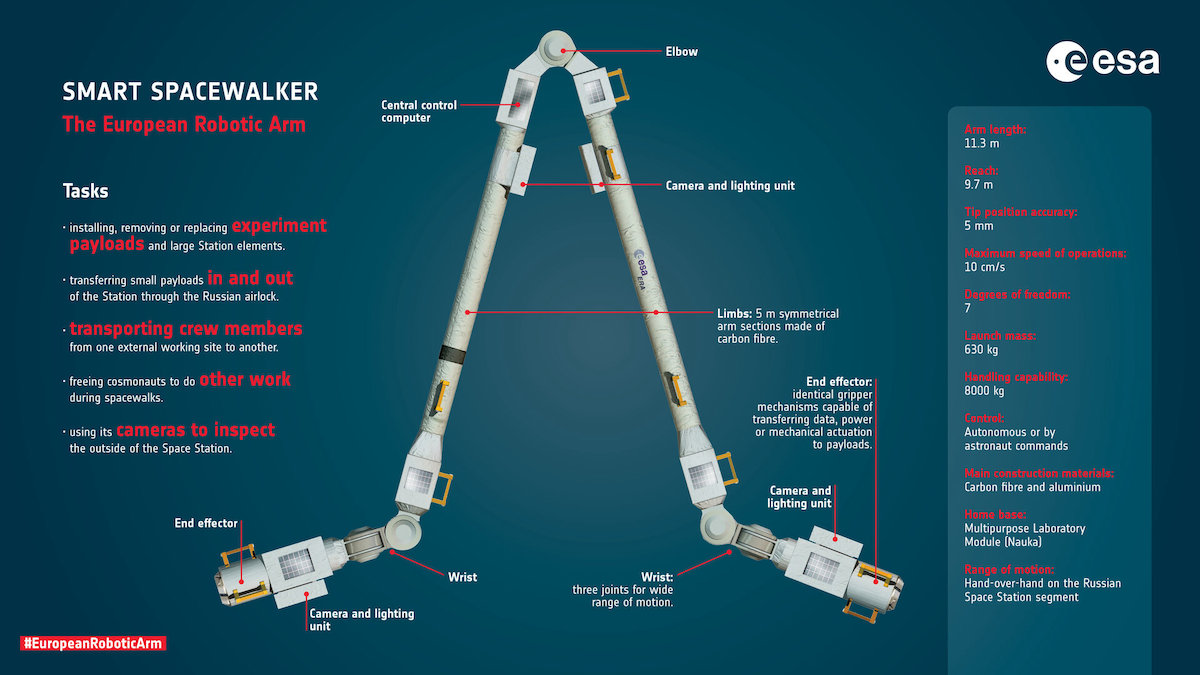Russian cosmonauts Oleg Artemyev and Denis Matveev ventured outside the International Space Station on Thursday for a planned six-and-a-half hour spacewalk to begin unlimbering the European Robotic Arm.
The cosmonauts opened the hatch to the Poisk airlock at 10:58 a.m. EDT (1458 GMT), marking the official start of the spacewalk. The excursion is the 250th spacewalk since 1998 in support of space station assembly and maintenance.
The spacewalk is the fifth Artemyev’s cosmonaut career, and the second for Matveev. Artemyev, Matveev, and crewmate Sergey Korsakov arrived at the space station last month on a Soyuz spacecraft.
Artemyev and Matveev’s previous spacewalk on April 18 began work to activate the European Robotic Arm, a 37-foot-long (11.3-meter) manipulator delivered to the station last July with Russia’s Nauka science module. The cosmonauts connected a control panel for future crews to command the robotic arm, then removed protective covers from various robot arm components, and installed handrails on the Nauka module.
On Thursday’s spacewalk, the cosmonauts plan to remove and jettison thermal blankets from the arm, and release launch locks that firmly held the arm in its folded configuration for the journey to the space station last year. The launch locks are located at the elbow and end effectors, or hands, of the European Robotic Arm.
Those tasks will free up the manipulator for movement. Artemyev and Matveev will monitor the first commanded movements of the robotic arm.
Artemyev is wearing a Russian Orlan spacesuit with red stripes. Matveev wears a spacesuit with blue stripes.

The European Robotic Arm is the third system of its kind at the station, joining the Canadian and Japanese robot arms on the U.S. section of the research complex.
Like the Canadian robotic arm, the European arm has the ability to “inchworm” between grapple fixtures, or base points, at multiple locations on the space station. While the Canadian arm is positioned on the U.S. segment of the complex, the European arm has access to the Russian modules.
With the launch locks released, Artemyev and Matveev will monitor the arm as it translates between base points Thursday in a “double walkoff” maneuver using both ends of the arm.
The cosmonauts working outside the station Thursday will also install more handrails on the robotic arm, and inspect a Kurs rendezvous radar antenna on the Russian Prichal module for a possible obstruction from debris. The Kurs system is used to help navigate Soyuz and Progress crew and cargo ships to the space station.
Full-scale development of the European Robotic Arm began in 1996, and the arm was in storage more than a decade to wait for Russia’s Nauka lab module to be ready for launch. The European arm was originally planned for launch on a NASA space shuttle.
“ERA is a bit different than the other manipulators that already on the station,” said Philippe Schoonejansm, the European Space Agency’s ERA project manager. “It can be fully preprogrammed in advance, which is helpful. It can be operated from external control panel, which the others do not have. So even when you’re doing a spacewalk, you can control ERA by just seeing and operating this control panel. But also it can operated from inside using only a laptop, so it doesn’t need any joysticks.”
ESA says the arm capable of carrying a load of more than 17,000 pounds, or 8 metric tons, with a precision of one-fifth of an inch (5 millimeters).
The next spacewalk to continue activating the European Robotic Arm is scheduled for late May.
Email the author.
Follow Stephen Clark on Twitter: @StephenClark1.
from Spaceflight Now https://ift.tt/IhVnLEK
via World Space Info







0 comments:
Post a Comment